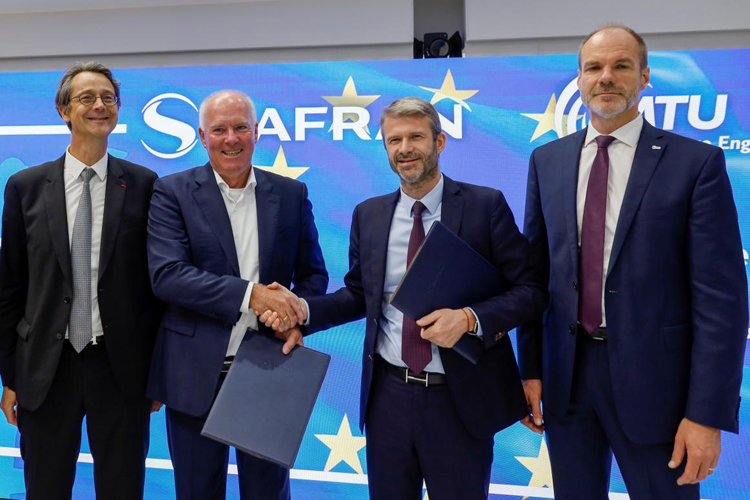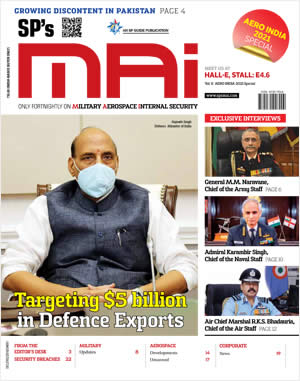INDIAN ARMED FORCES CHIEFS ON OUR RELENTLESS AND FOCUSED PUBLISHING EFFORTS

The insightful articles, inspiring narrations and analytical perspectives presented by the Editorial Team, establish an alluring connect with the reader. My compliments and best wishes to SP Guide Publications.

"Over the past 60 years, the growth of SP Guide Publications has mirrored the rising stature of Indian Navy. Its well-researched and informative magazines on Defence and Aerospace sector have served to shape an educated opinion of our military personnel, policy makers and the public alike. I wish SP's Publication team continued success, fair winds and following seas in all future endeavour!"

Since, its inception in 1964, SP Guide Publications has consistently demonstrated commitment to high-quality journalism in the aerospace and defence sectors, earning a well-deserved reputation as Asia's largest media house in this domain. I wish SP Guide Publications continued success in its pursuit of excellence.
- Indian Air Force Aims for Full Indigenous Inventory by 2047 — Air Chief Marshal A.P. Singh
- General Upendra Dwivedi takes over as the Chief of the Army Staff
- Rajnath Singh assumes charge as Defence Minister for the second consecutive term
- Admiral Dinesh K. Tripathi assumes Command of the Indian Navy as 26th Chief of the Naval Staff
- Prime Minister witnesses 'Bharat Shakti' – a Tri-Services Firing and Manoeuvre Exercise in Pokhran, Rajasthan
Safran and MTU Aero Engines team up to pave the way for a European engine anticipating the next-generation military helicopter

Safran Helicopter Engines and MTU Aero Engines have signed a Memorandum of Understanding (MoU) to create a 50/50 joint venture as an agile and lean structure intended to develop a new engine for the European Next Generation Rotorcraft Technologies (ENGRT) project.
Both partners are convinced that European armed forces need a new 100% European engine with advanced design maturity and affordable operating and maintenance costs, to power a military helicopter to enter service by 2040. Developing this next-generation engine demands efficient project management and quick and flexible decisionmaking. MTU Aero Engines and Safran Helicopter Engines have therefore forged a strong alliance that will form the core of an extended European partnership involving industrial partners from several other European nations.
“This alliance project led by Safran Helicopter Engines and MTU Aero Engines is set to ensure European sovereignty for the ENGRT project”, said Cédric Goubet, CEO of Safran Helicopter Engines. “the engine design will be perfectly adaptable to the future helicopter requirements, while incorporating breakthrough technologies such as hybrid-electric propulsion. It will be one of the most important collaborative programs in the history of European defense. Safran Helicopter Engines and MTU have long-standing experiences in leading joint industrial ventures, thereby conducive to the success of this new alliance.”
Michael Schreyögg, Chief Program Officer of MTU Aero Engines commented: “This future-oriented program is key to genuinely reinforcing European sovereignty, strengthening the European supply chain and fostering collaboration between MTU and our long-standing partner Safran. It marks another milestone in Europe’s defense history. The ambition to power the next-generation military helicopter complements our companies’ already established joint initiative to power the next-generation fighter within the FCAS program. Both strategic partners shape the future by maintaining strong relationships and involving partners across Europe.”
One of the main goals of this collaboration is to favor a future specific call for military helicopter engines in the European Defense Fund (EDF). Safran Helicopter Engines and MTU Aero Engines would then respond together with a capable consortium of partners.
The ENGRT project will explore technology options in anticipation of the next generation of military rotorcraft slated to enter service by 2040. The project will analyze future military requirements in this area in cooperation with European armed forces. Concepts of potential operations will be defined and tested using simulation tools. Different configurations of rotary wings will be studied: conventional, convertible or hybrid helicopters. Operational simulations will be set up to evaluate these options and the different mission scenarios. The project will also lead to the establishment of a roadmap and strategy regarding the modularity of future platforms, the maturation of required technologies, production methods, life-cycle costs and maintenance concepts.





